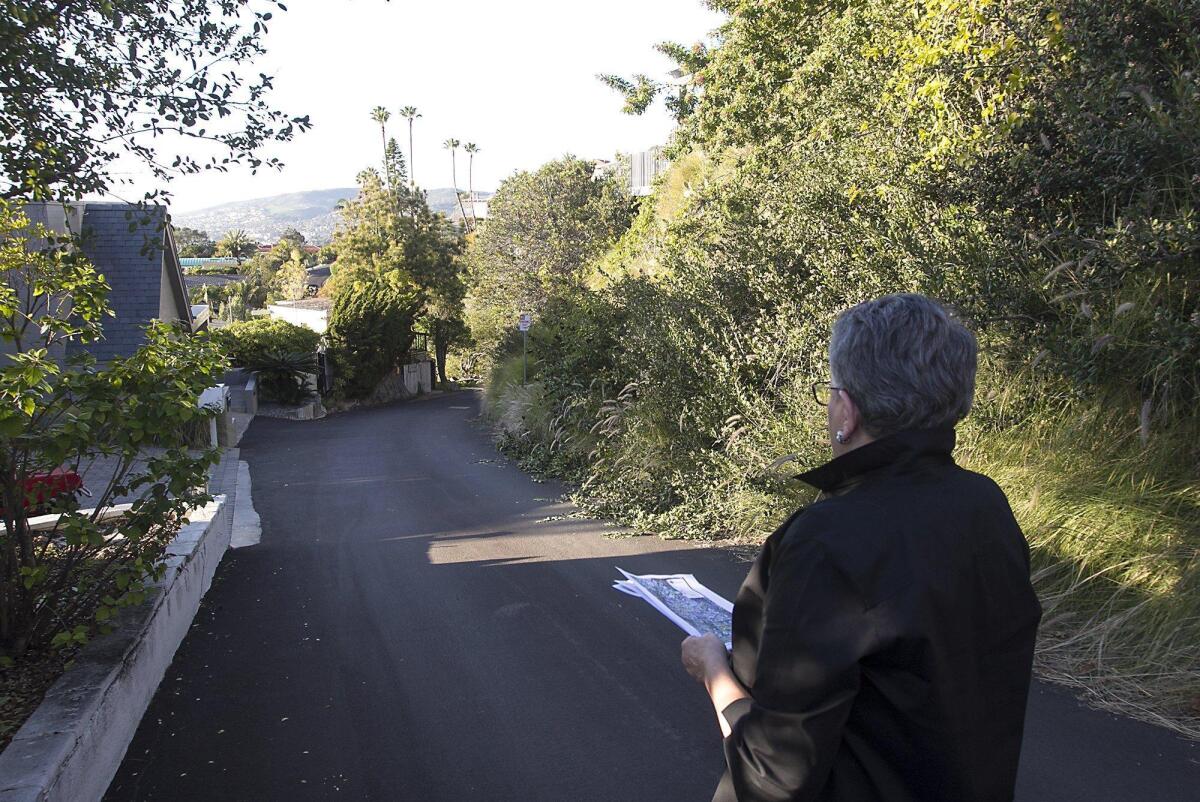Laguna Beach residents fear parking restrictions

- Share via
Laguna Beach residents’ concerns about losing coveted street parking while the city considers how to ensure adequate room for emergency-response vehicles such as fire engines and ambulances has the city’s attention.
A subcommittee of Laguna’s Emergency Disaster Preparedness Committee and city staff said they will be researching other options in addition to restricting parking restrictions, such as identifying areas where roads could be widened, Laguna Fire Chief Jeff LaTendresse wrote in an email Thursday.
Initially, the city is planning a yearlong pilot program that would limit parking on Corona Way, Duarte Way, Encina Way, Fontana Way, Hermosa Way, Iris Way, Juanita Way, Kilo Way, Lomita Way, Nido Way, Pala Way, Queda Way, Avenue W and San Clemente Street, according to a city staff report. These roads are often called the alphabet streets.
Laguna Fire Chief Jeff LaTendresse wrote in an email Thursday that it is unclear when the test period would start.
The city is considering banning parking on one or both sides of certain streets, some of which are narrow, steep and curved. Fire officials said these streets create difficulties for firefighters who might have to park engines hundreds of feet away and haul hoses and other equipment to the scene.
Residents said they understand the need for emergency response but don’t think a parking ban is necessary.
The trial would eliminate 90 to 100 spaces throughout the “alphabet” neighborhood, city Emergency Operations Coordinator Jordan Villwock said. But a city staff report says many of its streets already have parking restrictions, and emergency vehicles still have trouble maneuvering on them.
Mary Ann Loehr, who owns a house without a garage on Queda Way, said she would have to park along South Coast Highway and walk a quarter-mile to get home.
“Leave it as is, or correct the street to make it so it’s compatible with all the other streets in Laguna Beach,” Loehr said.
Loehr said Queda Way narrows at one point and suggests widening that portion.
The City Council in June directed the committee and Fire Department to gather community input and return with a proposal.
Committee members went on a ridealong through several neighborhoods, including Old Top of the World, Bluebird Canyon, Temple Hills, Arch Beach Heights, Alta Vista and Diamond-Crestview, and held public meetings.
“Why single out our neighborhood to do this?” resident Sam Dawson, who lives on Kilo Way, said about the pilot program. “If they do this, they should do it citywide.”
In a follow-up phone interview, LaTendresse said neighborhoods throughout the city were considered and, with firefighters’ feedback, this area was selected because it would affect the least number of houses.
According to the current proposal, Igal and Diane Silber stand to lose parking in front of their house on Nido Way.
“It’s going to be impossible for people to have guests, caregivers,” Diane Silber said.
“We believe these neighborhoods have not changed significantly in the last 20 years,” Silber said. “Why not use the safety element as the basis?”
The safety element is a portion of the general plan that deals with emergency planning and response.
The safety element, which was adopted in 1995, designated multiple areas with impaired access because of road configurations.
“Three of the most severely access-restricted neighborhoods are Bluebird Canyon, Canyon Acres and Diamond-Crestview,” according to the element. “All three neighborhoods are particularly susceptible to fire hazards, a situation aggravated by the narrow roadways in each neighborhood.”
“Even though it’s not one of the top three does not mean that it’s not a problem area,” LaTendresse said.
Residents suggested smaller fire trucks as a possible remedy, but Laguna receives help “almost on a daily basis” from other agencies such as Newport Beach and the Orange County Fire Authority, and has no control over the size of those engines, LaTendresse said.
Also, since Laguna does not have a ladder truck, a 40-to-50-foot-long vehicle that carries equipment for a variety of functions such as search and rescue and forcible entry, firefighters must carry the equipment on their engines.
“We can’t decrease the size [of engines] from what we have,” LaTendresse said.
Under the state’s fire code, new streets must be 36 feet wide if cars are allowed to park on both sides, 20 feet with no parking and 28 feet with cars allowed on one side.
Some of Laguna’s streets pre-date state rules and are not as wide as those requirements.
The city is willing to meet with residents who do not have garages to discuss options, LaTendresse said. He added that service professionals such as plumbers who need to make emergency repairs would be given exceptions.
The Emergency Disaster Preparedness Committee’s subcommittee is expected to present a report to the entire committee in March. The proposal would then go to the City Council.
Robert Zur Schmiede, the council liaison to the committee, has met with some of the residents and said adhering to one solution, such as putting up no parking signs, is not the answer.
“It should be a blended solution that will involve parking restrictions, but also, where do we find areas on streets that have unimproved right-of-ways,” Zur Schmiede said in alluding to possible street-widening opportunities.
For more information and to view a map of the affected streets, visit www.lagunabeachcity.net/cityhall/police/emergprep/emergency_access_improvement_program.htm
Twitter: @AldertonBryce
